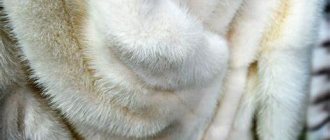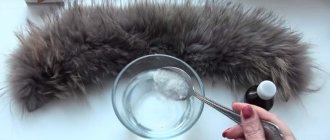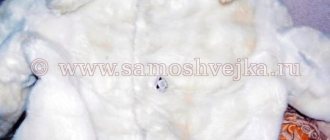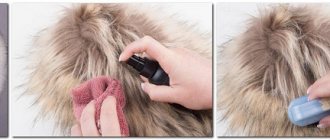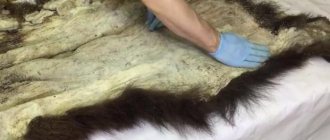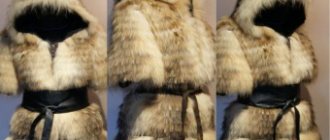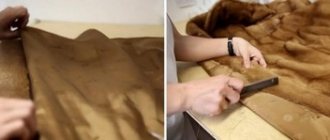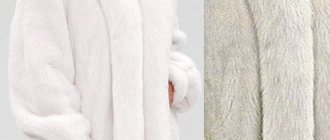Often, a favorite fur coat or vest loses its appearance, although other characteristics are still quite excellent. The fibers fade, become dull and give the product a very worn look. If you want to enjoy the warmth and comfort of your favorite thing, then you can shade it a little. But not everyone knows how to dye arctic fox fur at home.
You don’t have to bother with painting it yourself, but rather take the product to a special workshop, where everything will be done quickly and professionally. But the cost of such a service is often prohibitively high. It will be much cheaper to learn how to dye natural fur at home and do this work yourself.
Important: Please note that if the product is still new, it is strictly not recommended to dye it simply to change the color, since any dyeing of fur shortens its service life.
What fur can and cannot be dyed
Fur can be natural (dyed or natural) and artificial. You can paint any product, the main thing is to choose the right coloring agent.
White wool
Over time, white wool items turn yellow or dirty gray. Chlorine bleaches should not be used in such cases. You can make your wool whiter using available products. It is better to repaint things with special aniline dyes. It is recommended to bleach and dye only used clothes. It is not advisable to change the color of new things (the structure of the fibers deteriorates).
Wool bleaching products:
- 3 percent hydrogen peroxide (100 ml of peroxide per 2 liters of water);
- sodium thiosulfate (1 tablespoon of powder per 7 liters of water);
- table salt (1 tablespoon of salt per 1 liter of water);
- baking soda (2 tablespoons of soda per 4 liters of water);
- store-bought wool bleach (chlorine-free).
Arctic fox
After a few seasons, the white arctic fox turns yellow, and the color of the dyed fur becomes less intense and dull. You can restore the appearance of an arctic fox collar or fur coat by dyeing it. The main thing is to remember that you cannot paint a new product simply because you don’t like its color. It is recommended to paint only faded and yellowed Arctic foxes.
Products for dyeing fox fur:
- special aniline paint;
- acid dye;
- hair dye;
- hair lightener (chlorine-free);
- spray paint or tinting spray (Fur-Fresh).
Mink
A hat and even a mink collar can be repainted with ordinary hair dye. It is better to tint a fur coat with a tinting aerosol. You can also change the color of a fur product using aniline dye or acid dye. The easiest way is to use cream hair dye. This product can be bought at any supermarket. If the white mink has turned yellow, you can remove the yellowness using pharmaceutical hydrogen peroxide. The use of bleach with chlorine is prohibited.
Nutria
You can restore the natural color of nutria fur using alcohol or ordinary vodka. You just need to apply alcohol to a cotton swab and wipe the wool with it. After cleaning, the nutria needs to be dried, combed, and it will shine like new. It is prohibited to use bleaches containing chlorine. You can recolor your nutria using hair dye. It is better to tint with aerosol dye.
See also
Design and dimensions of paint booths for cars, their types and operating principles
Beaver
Beaver fur can be dyed using hair dye. The main thing is that it is darker than beaver fur. Tinting can be done with spray paint.
Mouton
A mouton fur coat can be repainted with cream hair dye, restorative dye for nubuck and suede, tint spray or liquid hair balm or aerosol dye. Do not use chlorine bleach.
A rabbit
It is better to recolor a rabbit fur coat using hair dye. To dye rabbit fur, you can use store-bought henna, basma, and gamma. Tinting is best done using spray paint.
Sheepskin
You can dye faded sheepskin using aniline dye, hair dye or aerosol tinting paint. The white color of the product can be restored using hydrogen peroxide and ammonia.
Artificial
A huge number of paints have been developed for dyeing faux fur. The main thing is to remember that such pile should not be dyed with regular hair dye. Faux fur cannot be machine washed. It is better to remove dirt using carpet cleaning detergents.
Dyeing fur in light shades
If the arctic fox's fur is quite dark, and dyeing it an even darker shade is not part of your plans, then you can bleach it at home. To do this, use a hair lightener, as well as regular hydrogen peroxide. If a brightening agent is used, it must be prepared according to the instructions.
If you use hydrogen peroxide, then prepare a solution in a ratio of water and peroxide 1:3. The prepared solution is applied to the entire surface of the product and left for no more than 15 minutes. It is not recommended to keep it for a long time, otherwise the tips of the fibers will become brittle like straw and not a trace will remain of their former luxury.
After lightening, you can dye the fur any color, but only after it has completely dried. Dyeing fur products is often not recommended; frequent dyeing leads to damage to the hair structure.
What can you paint with?
Fur products are repainted using various dyes. In order to refresh the white color and remove yellowness, use bleaches (not chlorine).
Hair dye
The simplest, relatively cheap and accessible way to transform natural fur products is to dye them using cream hair dye for women. You can buy this product at any supermarket. When working with hair dye, the main thing is not to wet the skin (inside). It is recommended to lubricate the skins with Vaseline, baby cream or glycerin before dyeing.
Aerosol
Using aerosol paint (Salamander, Furasol) you can refresh the color of faded dyed fur. True, spray is not used to radically change the shade of a fur coat.
Expert opinion
Zakharova Irina Yurievna
Cleaning professional with 15 years of experience. Our best expert.
Ask a Question
The aerosol is used only for tinting fur products and restoring color in certain areas.
Aerosol paint is used to color long and short fur. The main thing is to choose the right color of the spray; it should match the shade of the fur product. Spray painting fur coats is very easy. You need to spray the paint over the fur at a distance of 25-40 cm and rub it into the fur with a soft brush, and then dry the product and comb it.
Peroxide and ammonia for lightening
If the pile has turned yellow, you can bleach it using 3% hydrogen peroxide and 10% ammonia solution. You can buy these whitening products at any pharmacy. In order to lighten the pile, you need to apply bleach to a cotton swab or washcloth and wipe the fur. Sometimes the clarification process needs to be repeated 2-3 times.
Potassium permangantsovka
Only natural fox fur can be dyed with a weak solution of potassium permanganate. This product is no longer suitable for any wool. But potassium permanganate returns the fox to its original color.
See also
Painting lessons for beginners, how to learn to create paintings
Toning with tinted shampoo
Balm, spray or shampoo for tinting women's hair can be used to dye a fur coat. Unlike paint, such products do not contain ammonia and have a more gentle effect. Light tinting is used for old fur of poor quality, which falls out and flakes off. The dye is applied to the pile for 20-40 minutes. Then wash it off with water from the shower head. The color after painting remains only on the surface of the pile, but does not penetrate inside.
Special dyes
In hardware supermarkets you can buy special paints for dyeing fur. True, some coloring products have to be ordered via the Internet. For example, acid powder dyes. These dyes are used for professional wool dyeing.
At home, faded natural fur is usually tinted with aniline dyes.
Painting features
Each type of fur is beautiful and original in its own way. The painting of each of them also has its own characteristics:
- White rabbit, chinchilla or mink fur is the easiest and simplest to dye, because it does not require pre-lightening. You can use any color that can cover the yellowness that appears.
Tip: Keep in mind that rabbit fur is very sensitive to chemicals, so it must be dyed with extreme caution.
- Some furs have a high density of pile (for example, arctic fox). This must be taken into account before preparation and painting. Such products will require more paint and time. Although experts believe that arctic fox fur is the most convenient to work with, since the color lies very evenly on the fibers and lasts a long time.
- Before you dye mink fur at home, keep in mind that such things are much more difficult to work with, since mink hairs are reluctant to give in to new pigmentation. Mink fur
- It is almost impossible to lighten beaver fur properly, because its fur ends up with a dirty yellow tint.
- The muskrat is very unpredictable. It is very difficult to dye, and as a result of lightening, the fur acquires a pinkish tint with white splashes.
- How to dye faux fur at home? Faux fur has been at the forefront of fashion trends lately, but it can also lose its appearance over time. It can also be dyed, but never use hair dye. These products contain many aggressive substances that can hopelessly ruin your item.
What you need for work
To dye any fur, first of all, you need to buy paint. It is advisable to completely repaint only faded products. If faded or peeling spots appear on your fur coat in some areas, it is better to touch them up with a spray. The main thing is to choose the right shade of aerosol.
Methods for dyeing fur products:
- Spread (by rubbing oxidative paint or acid dye into the fur).
- Spraying, tinting (spraying aerosol paint over the pile).
Tips that will come in handy when dyeing fur:
- the paint should be darker than the original color of the fur product;
- during the dyeing process, do not wet the skin (inner space);
- It is forbidden to repaint new things;
- It is better to tint a large fur coat with an aerosol;
- Suede paint is suitable for painting small faded areas;
- you can do highlighting (dye individual strands);
- It is better to paint with a hair coloring brush;
- You can fix the color with 9% vinegar;
- It is better to dry the product with a hairdryer (if there is a “cold air” function);
- To clean the pile, it is recommended to use a washcloth and dishwashing detergent;
- It is better to protect the skin (inner space) with glycerin.
Processing technology
Dyeing fur coats is a complex multi-step process. Before it begins, the skin undergoes a number of procedures in the form of dressing and processing, on which, by the way, the final appearance of the product largely depends. After all, the main thing when processing any fur is not to spoil it, and to preserve all those properties for which mink is so valued.
So, first the procedure of cleaning and soaking the skin occurs, then tanning is performed, and then fleshing. It is the fleshing of the fur that ultimately makes it soft and elastic. Painting a mink coat is the final stage of processing.
How to prepare fur
You can repaint part of a fur product or the entire thing. The fur needs to be prepared for painting. Before dyeing, it is advisable to separate the fur collar from the main product. If you need to repaint the entire item, it is recommended to tear off the lining. Only clean things are painted. Dirty fur must be cleaned. Before cleaning the wool, it is advisable to lubricate the skin (underside) with glycerin on the reverse side.
You can place the fur coat on a wet sheet (nap side down) and use a beater to knock out dust and dirt from it.
Methods for cleaning fur products:
- a washcloth and soap solution (shampoo, washing powder, liquid soap, dishwashing detergent);
- with a damp cloth and 3% hydrogen peroxide dissolved in water;
- soft brush and solution (soda + 3% hydrogen peroxide + salt + shampoo);
- store-bought fur cleaner (Furasol cleaning spray).
When cleaning, try not to wet the skin. Only the fur is cleaned. When cleaning, it is advisable to place the fur product vertically. After cleaning with detergent, the fur should be wiped with a damp, clean washcloth and then dried with a hair dryer. After drying, clean wool should be combed with a brush.
See also
How long does oil paint take to dry on different surfaces?
Preparation
In order for you to get a very good effect, the fur product must be prepared for painting. Then the paint will apply much more evenly and there will be no bald spots. The most important thing is to thoroughly clean your fur coat or vest. To do this, you need to prepare a mixture of the following substances:
- 2 tbsp. l. salt;
- 1 tbsp. l. ammonia;
- 2 tbsp. l. soda;
- 1 tbsp. l. washing powder;
- 2 liters of warm (not hot) water.
All components must be mixed and the resulting mixture carefully applied to the fur. Lightly brush the bristles so that not only the top, but also the bottom part is cleaned. Then moisten a clean cloth with water and wipe the fur from the composition.
After such cleaning, the fur must be dried naturally, without using heaters or a hair dryer. It is also not recommended to leave the product exposed to direct sunlight.
Step-by-step coloring algorithm
Before painting the main product, it is advisable to conduct a test on a small piece of fur or on a hem. Before painting, you need to put rubber or plastic gloves on your hands. It is recommended to apply the dye to the fur using a hairdressing brush for dyeing women's hair or a brush.
Painting
Stages of dyeing a fur product:
- lubricate the inside with glycerin;
- prepare a coloring agent;
- apply dye to the wool using a hair dye brush;
- dye all strands evenly;
- simultaneously with dyeing, comb hairs in the direction of natural growth;
- cover the fur with paint applied to it with plastic film;
- wait 25-45 minutes until the wool is completely dyed (the exposure time is written in the instructions for the paint);
- At the end of the exposure, wash off the paint with water using a shower head.
Lock color
After painting, it is recommended to fix the color. The new shade can be fixed using a vinegar solution (2.5 tablespoons of 9% vinegar per liter of water). You can rinse the fur with a balm dissolved in water, which is usually sold along with hair dye. After fixing the color, the fur product should be blotted with a dry terry towel.
Drying
It is advisable to dry the dyed fur in the fresh air, for example, on the balcony. You can use a household hair dryer to dry the pile. Under the influence of a stream of cool air, the wool quickly dries and becomes fluffy. The main thing is not to dry out the flesh and not to dry the fur with hot air. It is advisable to dry the pile as quickly as possible before the water saturates the skin.
How to clean arctic fox from yellowness at home?
The worst thing that can happen to an expensive purchase is the loss of its original aesthetics. Gradually this happens even with the most expensive wardrobe items. But proper care will prevent the appearance of destructive yellowness:
- Heat an empty frying pan over medium heat and pour a couple of tablespoons of regular flour into it. As soon as it gets hot, you should immediately sprinkle it on the stains. After a few hours, you can shake the product and it will be as good as new;
- Instead of flour, use starch or purified rye bran. The cleaning technology is the same as in the previous case;
- Another indispensable housewife's assistant in the fight against old stains is vinegar. A small piece of cotton wool is moistened with the liquid and problem points are treated with it.
It is important to avoid strong mechanical impact. Thus, it is strictly forbidden to forcefully rub or use a household hair dryer to dry the fur.
How to care for a fur product after dyeing
If the fur was dyed using a spread method (using paint), the result would be a color that is resistant to moisture and ultraviolet radiation. The shade will remain for another 2-4 seasons. The main thing in a painted product is not to get caught in the rain. The wet pile should be immediately dried with a stream of cool air and combed.
If the fur is painted by spraying, that is, using aerosol paint, the color will not last long.
After all, such a coloring agent only tints the pile. The paint will remain on your hands and objects in contact with the fur (on your bag, belt). The shade will easily come off if your fur coat is caught in heavy snow. The wet pile should be dried with a stream of cold air and combed. Faded areas can be re-touched with spray.


